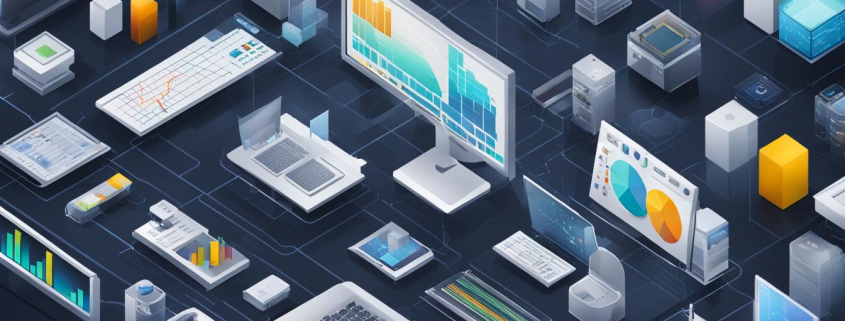What is IT Infrastructure Monitoring – Our Guide
Welcome to our comprehensive guide on IT infrastructure monitoring. In today’s digital landscape, effective management and monitoring of IT infrastructure have become crucial for businesses of all sizes. In this guide, we will explore the importance of IT infrastructure monitoring, how it works, what to monitor, choosing the right monitoring tools, addressing challenges, and implementing best practices to ensure the smooth operation of your IT infrastructure.
IT infrastructure monitoring involves tracking and measuring the performance and availability of various components such as servers, network layers, firewalls, databases, and more. By closely monitoring system performance and resource utilization, businesses can proactively identify and resolve issues before they escalate, ensuring optimal system reliability and uptime.
Monitoring your IT infrastructure not only helps prevent costly downtime but also enhances customer satisfaction and improves resource efficiency. Let’s dive deeper into the world of IT infrastructure monitoring and discover how it can benefit your business.
Key Takeaways:
- IT infrastructure monitoring is essential to track and measure the performance and availability of IT systems and resources.
- Effective monitoring practices can boost system reliability, prevent downtime, and improve resource efficiency.
- IT infrastructure monitoring relies on telemetry data collected through passive and active monitoring methods.
- Various components like servers, network layers, firewalls, and databases should be monitored to ensure the overall health of the infrastructure.
- Choosing the right monitoring tool and implementing best practices can help address challenges and optimize IT infrastructure management.
The Importance of IT Infrastructure Monitoring
IT infrastructure monitoring is crucial for maintaining system reliability and ensuring the smooth operation of IT resources. By monitoring the performance and availability of various components, businesses can detect and address issues early, improving system stability and minimizing downtime.
Early detection is a key benefit of IT infrastructure monitoring. By constantly monitoring critical metrics such as CPU usage, memory usage, and network traffic, businesses can identify potential problems before they escalate into major issues. This proactive approach allows for timely intervention and resolution, preventing costly outages and disruptions to operations.
Effective IT infrastructure monitoring also promotes resource efficiency. By monitoring resource utilization and identifying bottlenecks or inefficiencies, businesses can optimize their IT infrastructure to ensure maximum utilization and cost-effectiveness. This can lead to significant savings in terms of both time and resources.
Furthermore, IT infrastructure monitoring plays a crucial role in application testing. By monitoring system performance during testing, businesses can identify any issues or areas for improvement before deploying applications in a live environment. This ensures that applications perform optimally and meet user expectations, enhancing customer satisfaction and overall business performance.
| Benefits of IT Infrastructure Monitoring: |
|---|
| System reliability |
| Early problem detection |
| Resource efficiency |
| Improved application testing |
In conclusion, IT infrastructure monitoring is vital for ensuring system reliability, detecting issues early, optimizing resource utilization, and improving application testing. By implementing effective monitoring practices and utilizing the right tools and services, businesses can enhance the performance and availability of their IT infrastructure, leading to improved operational efficiency and customer satisfaction.
Key Takeaways:
- IT infrastructure monitoring ensures system reliability and minimizes downtime.
- Early detection of issues helps prevent major problems and disruptions.
- Monitoring promotes resource efficiency and cost-effectiveness.
- Application testing benefits from continuous system performance monitoring.
How IT Infrastructure Monitoring Works
IT infrastructure monitoring is a crucial aspect of maintaining the performance and availability of IT systems and resources. To understand how IT infrastructure monitoring works, it is essential to grasp the concept of telemetry data. Telemetry data is collected from target systems using either passive or active monitoring techniques. Passive monitoring involves gathering information without interfering with operations, while active monitoring utilizes agents to actively probe infrastructure systems in real-time.
Monitoring tools collect various types of data, including system and application performance metrics, environmental information, and network traffic data. Once collected, this data is parsed, indexed, and stored in a monitoring solution. This allows for easy querying, aggregation, and visualization of the data in dashboards for analysis and reporting.
By leveraging these monitoring tools and techniques, organizations gain valuable insights into the performance and health of their IT infrastructure. They can identify and address issues promptly, optimize resource utilization, and make informed decisions to ensure the smooth functioning of their IT systems.
Telemetry Data and Monitoring Techniques
Telemetry data, the cornerstone of IT infrastructure monitoring, is collected through passive or active monitoring techniques. Passive monitoring allows for data collection without impacting system operations, providing a non-intrusive way to gather insights. On the other hand, active monitoring employs agents to actively probe infrastructure systems, offering real-time visibility into system performance and potential issues.
Both techniques have their advantages. Passive monitoring is less resource-intensive and ideal for monitoring large-scale environments. It captures telemetry data from various sources, such as system logs and network traffic, enabling a comprehensive view of the IT infrastructure. Active monitoring, with its proactive approach, allows for immediate detection of performance bottlenecks, security risks, and other issues. By actively probing systems, it provides real-time insights into the health and availability of IT resources.
| Monitoring Technique | Advantages |
|---|---|
| Passive Monitoring |
|
| Active Monitoring |
|
With these monitoring techniques and the power of telemetry data, IT infrastructure monitoring becomes a vital tool in ensuring the reliability, performance, and availability of systems. By proactively monitoring and analyzing relevant data, organizations can address issues promptly, optimize resource utilization, and make informed decisions to support their business goals.
What to Monitor in Your IT Infrastructure
When it comes to monitoring your IT infrastructure, it’s crucial to keep an eye on various components to ensure its optimal performance. By monitoring servers, network layers, firewalls, load balancers, databases, and containers, you can proactively identify and address any potential issues that may impact your system’s health and performance.
Here are some key metrics and areas that you should consider monitoring:
- Servers: Monitor for low memory, low disk space, and high CPU usage to prevent performance bottlenecks and ensure efficient resource utilization.
- Network layers: Keep an eye on excessive connection requests, high network latency, and dropped or lost network packets to maintain smooth and reliable network communication.
- Firewalls: Monitor for excessive failed requests and abnormal traffic patterns to ensure the security and integrity of your network.
- Load balancers: Keep track of load balancing performance metrics to optimize resource allocation and maintain high availability for your applications.
- Databases: Monitor for slow transactions, timeouts, and backup statuses to ensure the efficient and reliable operation of your databases.
- Containers: Keep an eye on container performance metrics such as CPU usage, memory usage, and network latency to optimize containerized applications and ensure their smooth operation.
By monitoring these components and metrics, you can gain valuable insights into the health and performance of your IT infrastructure. This proactive approach allows you to proactively address any issues, optimize resource utilization, and ensure the overall stability and reliability of your systems.
| Component | Metrics to Monitor |
|---|---|
| Servers | Low memory, low disk space, high CPU usage |
| Network layers | Excessive connection requests, high network latency, dropped or lost network packets |
| Firewalls | Excessive failed requests, abnormal traffic patterns |
| Load balancers | Load balancing performance metrics |
| Databases | Slow transactions, timeouts, backup statuses |
| Containers | CPU usage, memory usage, network latency |
Monitoring these components and metrics not only helps in identifying and resolving issues promptly but also ensures optimal resource utilization and the overall health and performance of your IT infrastructure.
Choosing an IT Infrastructure Monitoring Tool
When it comes to selecting an IT infrastructure monitoring tool, there are several factors to consider. The right tool can help you effectively track and manage the performance and availability of your IT systems, ensuring that everything runs smoothly. Here are some key considerations to keep in mind:
- Passive vs. Active Monitoring: Determine whether you need a tool that supports passive monitoring, which collects infrastructure activity logs without interfering with operations, or active monitoring, which uses agents to actively probe infrastructure systems in real-time. Depending on your specific needs, you may require one or both approaches.
- Scalability: Consider the scalability of the monitoring tool. As your infrastructure grows and evolves, you’ll want a tool that can handle the increased workload and continue to provide accurate and reliable monitoring capabilities.
- Integration: Look for a tool that seamlessly integrates with your existing infrastructure environment. This will make it easier to set up and use, as well as ensure compatibility with your current systems and processes.
- Automated Activity: Automation is crucial for efficient monitoring. Choose a tool that offers automated activity tracking and reporting, reducing the need for manual intervention and saving time and resources.
It’s also a good idea to test the tool in a development environment before deploying it in your live infrastructure. This will give you a chance to evaluate its features and performance, ensuring that it meets your requirements and expectations.
By carefully considering these factors and finding the right IT infrastructure monitoring tool, you can enhance the performance and reliability of your systems, proactively identify and address issues, and optimize the overall health of your IT infrastructure.
Please accept YouTube cookies to play this video. By accepting you will be accessing content from YouTube, a service provided by an external third party.
If you accept this notice, your choice will be saved and the page will refresh.
Addressing Challenges in IT Infrastructure Monitoring
Implementing and improving IT infrastructure monitoring can come with various challenges that organizations need to address. These challenges include upfront costs, personnel expenses, managing large infrastructure size, and consolidating multiple monitoring tools. By understanding and finding solutions to these challenges, businesses can ensure the effectiveness and efficiency of their IT infrastructure monitoring practices.
Upfront Costs
One of the challenges organizations face when implementing IT infrastructure monitoring is the upfront costs associated with acquiring sophisticated tools and software. These costs can sometimes be a barrier for smaller businesses with limited budgets. To address this challenge, businesses can consider cost-effective monitoring solutions that offer flexible payment plans based on the data processed or the number of users. By exploring different pricing options, organizations can find a solution that aligns with their financial capabilities while still providing the necessary monitoring capabilities.
Personnel Expenses
An additional challenge in IT infrastructure monitoring is the personnel expenses incurred for hiring or training experts to manage and maintain the monitoring system. To address this challenge, businesses can consider outsourcing monitoring tasks to the vendor or investing in training programs to enhance the skills of in-house staff. By leveraging external expertise or developing internal talent, organizations can ensure the efficient operation of their monitoring systems without incurring excessive personnel expenses.
Infrastructure Size and Monitoring Tool Consolidation
Managing large infrastructure size and consolidating multiple monitoring tools can also present challenges in IT infrastructure monitoring. Businesses with expansive networks may struggle to effectively monitor and maintain the health and performance of their infrastructure. To address this challenge, organizations can employ scalable monitoring tools that can handle the growth and expansion of the enterprise. Additionally, consolidating multiple monitoring tools into a single comprehensive solution can provide a clear and comprehensive view of the network without conflicting reports and overlapping functionalities.
By addressing these challenges and finding suitable solutions, organizations can overcome obstacles in IT infrastructure monitoring and ensure the smooth operation of their systems. With effective monitoring practices in place, businesses can detect and resolve issues promptly, optimize resource utilization, and ensure the overall health and performance of their IT infrastructure.
Setting Infrastructure Monitoring Goals and Benefits
Monitoring the IT infrastructure is crucial for ensuring the smooth operation and reliability of our systems. By setting clear goals and objectives, we can maximize the benefits that infrastructure monitoring brings to our organization.
Goal 1: System Reliability
One of the primary goals of IT infrastructure monitoring is to enhance system reliability. By continuously monitoring the performance and availability of our systems, we can identify and address potential issues before they escalate into major problems. This proactive approach helps us minimize downtime, improve system performance, and ultimately deliver a reliable experience to our customers and end-users.
Goal 2: Early Problem Detection
Efficient IT infrastructure monitoring enables early problem detection, allowing us to respond promptly and prevent disruptions. By monitoring key metrics such as CPU usage, memory utilization, and network traffic, we can identify anomalies and take immediate action to resolve them. This proactive monitoring approach helps us maintain a stable and secure environment, safeguarding our systems from potential security risks and vulnerabilities.
Goal 3: Resource Efficiency
Optimizing resource utilization is another important goal of infrastructure monitoring. By monitoring performance metrics and analyzing data, we can identify areas of inefficiency and implement improvements to maximize resource utilization. This can lead to cost savings, improved operational efficiency, and a more streamlined infrastructure that meets the demands of our organization.
Benefits of Infrastructure Monitoring
Implementing a comprehensive infrastructure monitoring plan brings several benefits to our organization:
- Accurate System Requirement Forecasting: By monitoring system performance and resource utilization, we can forecast future requirements accurately. This helps us plan for capacity upgrades, hardware replacements, and software updates, ensuring the scalability and sustainability of our infrastructure.
- Streamlined Network and Infrastructure Management: Infrastructure monitoring provides visibility into the network and infrastructure components, enabling efficient management and control. We can identify and resolve bottlenecks, optimize network traffic, and streamline operations, resulting in a more agile and responsive infrastructure.
- Ease of Identifying Congestion Points: With continuous monitoring, we can easily identify congestion points and areas of high traffic. This allows us to proactively address these issues, ensuring optimal performance and preventing potential disruptions.
- Improved System Availability and Uptime: Infrastructure monitoring helps us detect anomalies and potential failures, allowing us to take prompt action and prevent costly outages. By ensuring high system availability and uptime, we deliver a seamless experience to our users and maintain their trust.
By setting clear goals for infrastructure monitoring and leveraging the benefits it brings, we can enhance the reliability, efficiency, and performance of our IT infrastructure. Through proactive monitoring and prompt action, we can minimize downtime, improve resource utilization, and optimize the overall health and performance of our systems.
Implementing Effective IT Infrastructure Monitoring Practices
Implementing effective IT infrastructure monitoring practices is crucial for maintaining the reliability and performance of your systems. By combining passive and active monitoring methods, you can gain valuable insights into the health and functionality of your infrastructure.
Passive monitoring, such as log monitoring, allows you to collect and analyze infrastructure activity logs. By tracking these logs, you can identify any unusual events or patterns that may indicate potential issues. This method is particularly useful for detecting security breaches or system errors.
On the other hand, active monitoring involves using agent-based software to continuously probe your infrastructure systems for errors in real-time. This proactive approach allows you to quickly identify and address any performance or availability issues before they impact your users.
The Benefits of System Reliability
Implementing effective IT infrastructure monitoring practices ensures the reliability of your systems. By continuously monitoring performance metrics, application performance, and environmental data, you can proactively detect and address issues that could lead to system failures or downtime. This level of vigilance helps to minimize disruptions and maintain the smooth operation of your IT infrastructure.
“Effective monitoring practices help ensure system reliability by continuously monitoring and analyzing performance metrics, application performance, and environmental data.”
Furthermore, by implementing these monitoring practices, you can gain valuable insights into the utilization and performance of your infrastructure resources. This data allows you to optimize resource allocation, improve system efficiency, and make informed decisions regarding capacity planning and scaling.
Table: Comparing Passive and Active Monitoring
| Passive Monitoring | Active Monitoring | |
|---|---|---|
| Definition | Collecting and analyzing infrastructure activity logs without interfering with operations | Using agent-based software to actively probe infrastructure systems in real-time |
| Use Case | Identifying unusual events or patterns that may indicate security breaches or system errors | Proactively detecting and addressing performance or availability issues in real-time |
| Key Benefit | Passive monitoring allows for retrospective analysis and identification of historical issues | Active monitoring enables real-time detection and immediate response to system issues |
| Drawback | May not capture issues that do not generate logs or leave traces | Requires additional resource utilization for active probing |
Conclusion
Implementing effective IT infrastructure monitoring practices is essential for maintaining the reliability and performance of your systems. By combining passive and active monitoring methods and continuously analyzing performance metrics and environmental data, you can proactively detect and address issues, optimize resource utilization, and make informed decisions for the smooth operation of your IT infrastructure.
Choosing the Right IT Infrastructure Monitoring Service
When it comes to IT infrastructure monitoring, choosing the right service can make a significant difference in the performance and reliability of your systems. Here are some factors to consider:
Service Plan:
Look for a monitoring service that offers flexible service plans tailored to your specific needs. Whether you have a small infrastructure or a large enterprise environment, a customizable service plan allows you to scale your monitoring capabilities as your business grows.
Customizable Dashboards:
Effective monitoring requires clear visibility into your infrastructure. Look for a service that provides customizable dashboards, allowing you to monitor the metrics and data that are most important to your organization. The ability to customize your dashboards ensures that you have the information you need at your fingertips.
Support:
Reliable support is crucial when it comes to monitoring your IT infrastructure. Choose a service provider that offers comprehensive support, including technical assistance and troubleshooting. This ensures that you have the assistance you need when problems arise and allows you to minimize downtime.
Cloud-Native Approach:
In today’s digital landscape, a cloud-native approach to IT infrastructure monitoring is essential. Look for a service that understands the unique challenges and opportunities of the cloud and provides seamless integration with your cloud-based systems. A cloud-native approach ensures that your monitoring solution is optimized for the scalability and agility of the cloud.
By considering these factors, you can choose an IT infrastructure monitoring service that meets your specific needs and helps you optimize the performance and reliability of your systems.
Table: Comparison of IT Infrastructure Monitoring Services
| Service | Service Plan | Customizable Dashboards | Support | Cloud-Native Approach |
|---|---|---|---|---|
| Service A | Multiple plans available | Yes | 24/7 technical support | Full integration with leading cloud platforms |
| Service B | Flexible plans based on infrastructure size | Customizable widgets and visualizations | Email and phone support during business hours | Native support for all major cloud providers |
| Service C | Customized plans based on specific requirements | Drag-and-drop dashboard builder | 24/7 support with dedicated account manager | Cloud-agnostic monitoring solution |
This table provides a comparison of different IT infrastructure monitoring services in terms of their service plans, customizable dashboards, support options, and cloud-native approach. Use this table as a guide to help you make an informed decision when choosing the right monitoring service for your organization.
The Nutanix Prism for Cloud Monitoring
When it comes to infrastructure monitoring and management for cloud workloads, the Nutanix Prism is a powerful and comprehensive solution. With its customizable dashboards, monitoring alerts, and cloud-native approach, Nutanix Prism simplifies the monitoring of cloud workloads and infrastructure components.
By utilizing the Nutanix Prism, businesses can ensure the smooth performance of their IT infrastructure and improve operational efficiency. Its customizable dashboards provide a clear and intuitive view of the infrastructure, allowing for quick identification of any potential issues or bottlenecks. The monitoring alerts enable proactive problem detection, allowing for timely interventions and minimizing downtime.
Furthermore, the cloud-native approach of Nutanix Prism ensures seamless integration and management of cloud workloads. This approach enables businesses to leverage the benefits of cloud computing while maintaining visibility and control over their infrastructure. Whether it’s monitoring virtual machines, containers, or storage systems, Nutanix Prism provides a comprehensive solution that meets the needs of modern cloud-based environments.
| Key Features of Nutanix Prism | Benefits |
|---|---|
| Customizable dashboards | Improved visibility and quick identification of issues |
| Monitoring alerts | Proactive problem detection and minimized downtime |
| Cloud-native approach | Seamless integration and management of cloud workloads |
| Comprehensive monitoring | Efficient monitoring of virtual machines, containers, and storage systems |
In summary, Nutanix Prism offers a powerful solution for infrastructure monitoring and management in cloud environments. Its customizable dashboards, monitoring alerts, and cloud-native approach ensure improved visibility, proactive problem detection, and seamless integration. By leveraging the capabilities of Nutanix Prism, businesses can maximize the performance and efficiency of their IT infrastructure.
Conclusion
In conclusion, IT infrastructure monitoring is a crucial practice for businesses to ensure the performance, availability, and reliability of their IT systems and resources. By setting clear goals and implementing effective monitoring practices, organizations can reap a wide range of benefits. These benefits include improved system reliability, early detection of problems, enhanced resource efficiency, and informed decision-making.
However, implementing and maintaining IT infrastructure monitoring strategies come with their own set of challenges. Upfront costs, personnel expenses, managing large infrastructure size, and consolidating multiple monitoring tools can pose obstacles. It is important to carefully consider the cost-effectiveness of monitoring solutions, explore outsourcing options for monitoring tasks, and leverage scalable tools to manage larger infrastructures.
By adopting a proactive and strategic approach to IT infrastructure monitoring, businesses can optimize the performance and availability of their IT infrastructure, minimize costly outages, and stay ahead of potential issues. With the right tools, services, and monitoring strategies in place, organizations can ensure the smooth operation of their IT systems and make data-driven decisions to drive business success.
FAQ
What is IT infrastructure monitoring?
IT infrastructure monitoring is the process of tracking and measuring the performance and availability of IT systems and resources. It involves monitoring items like CPU usage, memory usage, disk space, network traffic, and latency. An IT infrastructure monitoring tool provides visibility into all aspects of the IT infrastructure and helps identify and fix issues.
Why is IT infrastructure monitoring important?
IT infrastructure monitoring ensures system reliability, helps in the early detection of problems and security risks, improves resource efficiency, and yields more productive results during application and workload testing. It boosts system availability, prevents downtime, improves system forecasting, streamlines network and infrastructure management, and identifies congestion points.
How does IT infrastructure monitoring work?
IT infrastructure monitoring relies on telemetry data collected through passive monitoring, which gathers information without interfering with operations, or active monitoring, which uses agents to actively probe infrastructure systems in real-time. Monitoring tools collect a wide range of data, including system and application performance metrics, environmental information, and network traffic data.
What should I monitor in my IT infrastructure?
When monitoring IT infrastructure, it is important to monitor various components such as servers, network layers, firewalls, load balancers, block storage systems, databases, and containers. Common metrics to monitor include low memory, low disk space, high CPU usage, excessive connection requests, slow transactions, high network latency, excessive failed requests, dropped or lost network packets, timeout warnings, and backup statuses of servers and databases.
How do I choose an IT infrastructure monitoring tool?
When choosing an IT infrastructure monitoring tool, consider whether it supports passive and active monitoring approaches. Look for tools that offer scalability, integration with your infrastructure environment, automated activity, customized alerts, and the ability to test the tool in a development environment before deploying it in the live infrastructure.
What challenges are associated with IT infrastructure monitoring?
Challenges in IT infrastructure monitoring include upfront costs of sophisticated tools and software, personnel expenses for hiring or training experts, managing large infrastructure size, and consolidating multiple monitoring tools. Consider the cost-effectiveness of monitoring solutions, address personnel expenses by outsourcing monitoring tasks, manage large infrastructure size by using scalable monitoring tools, and consolidate monitoring tools for a clear and comprehensive view of the network.
How do I set goals for infrastructure monitoring and what are the benefits?
Set goals for infrastructure monitoring such as boosting system reliability, detecting problems and security risks early, improving resource efficiency, and yielding more productive results during application and workload testing. The benefits include more accurate system requirement forecasting, streamlined network and infrastructure management, greater ease of identifying congestion points, and improved system availability and uptime.
How do I implement effective IT infrastructure monitoring practices?
Effective IT infrastructure monitoring practices involve a combination of passive and active monitoring methods. Passive monitoring includes log monitoring, while active monitoring involves using agents to actively probe infrastructure systems for errors. By implementing these practices, businesses can detect and address issues early, enhance system performance, and improve overall IT infrastructure management.
What should I consider when choosing an IT infrastructure monitoring service?
When choosing an IT infrastructure monitoring service, consider service plans that offer scalability, customizable dashboards, and monitoring alerts tailored to your specific needs. Look for a provider that offers reliable support and consulting services, understands the importance of a cloud-native approach, and provides seamless access to infrastructure management tools.
What is Nutanix Prism and how does it help with cloud monitoring?
Nutanix Prism is a comprehensive and seamlessly integrated solution for infrastructure monitoring and management. It offers features like customizable dashboards, monitoring alerts, and a cloud-native approach, simplifying the monitoring of cloud workloads and infrastructure components. By utilizing Nutanix Prism, businesses can improve the efficiency of their operations and ensure the smooth performance of their IT infrastructure.
- About the Author
- Latest Posts
Mark is a senior IT technician at Biteno.com . He writes about Linux, Windows and Software.







